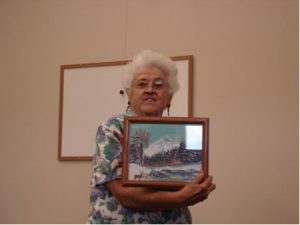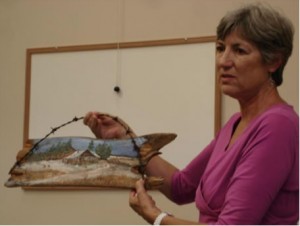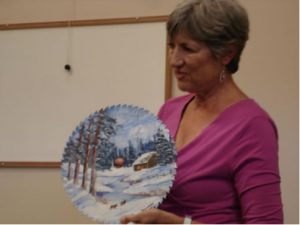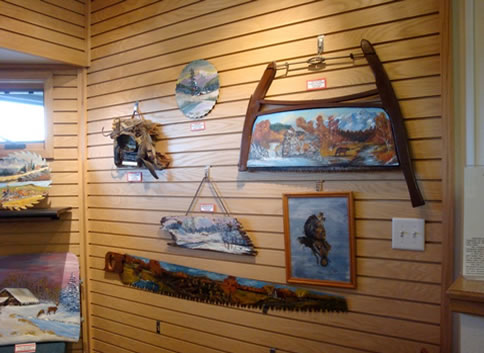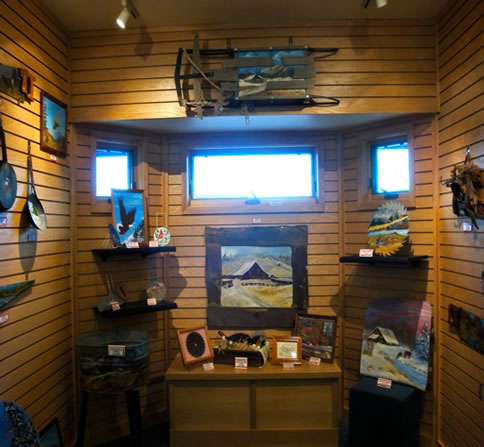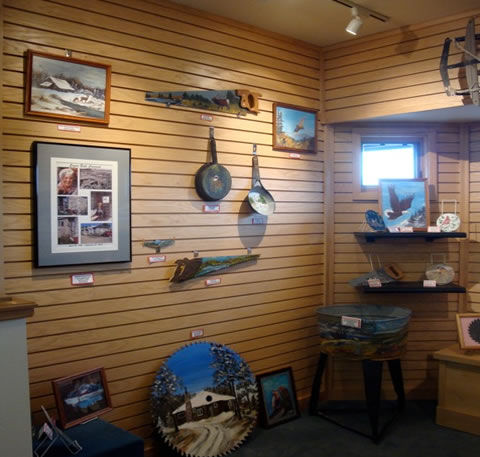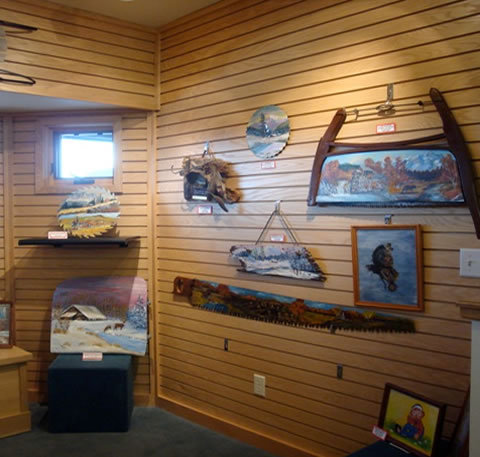“Sugarbabe Day” at the Red Feather Lakes Library
August 11, 2012
Sponsored by the Red Feather Historical Society
Pat Clemens, President of the RFHS, presiding
[Transcript available as PDF file]
Reader’s Note: You may also be interested in reading more about Sugarbabe Carnival’s Life History.
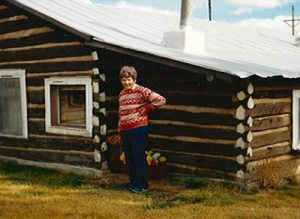
*****
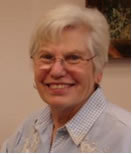
Pat Clemens:
Hi, I’m Pat Clemens and I’m the president of the Red Feather Historical Society. I’ve had this idea – we did a history of Red Feather last year – and this is kind of a continuation of it by featuring an historical figure in Red Feather. Sugarbabe was a good one to do because she was quite a character. A few of her family members came and Jody Morrison her daughter, and Larry, and their daughter Gina (Maes). We have an article in our (Summer 2012) newsletter about Sugarbabe and Jody graciously gave us some information. I had a few articles in our files too about Sugarbabe. What we want you to do, is tell your story. Linda Bell is here and she is going to record everybody’s voice, and when we do that, we’d like to have you say your name.
I guess I could start out by … I haven’t been here that long, 15 years, but I did know her. I went on a (RFHS) trip with her and in fact we went to her cabin. I remember riding in the car with her. I think we were going to one of the dude ranches. She wanted to stop and take pictures of all the old barns. Then I do remember her at her cabin and she talked to us about Billy and the cabin, and how long she’d lived there. She also read us a poem which was written for her, which is in our book. We have – the family had a book which was put together by Sue Beshears and who else? (Answers from the audience: Sue Link and Jan Mills.) You’ll have to look through this. I guess it was here for her memorial. I put together a book also and I don’t have all the pictures that they do, but I’m putting together a book to be kept in the library along with the recording and transcript and another recording we have of her at Ellis Island. Her life story at Ellis Island. We might also be able to put that on the web with permission. We’ll also have copies in the library.

Elizabeth (Libby) Jefferson:
We used to pick Sugarbabe up to go up the Cavalryman’s Restaurant in Laramie for a meal. She’s walk clear out to the highway to meet us. Never waited for us to drive after her and she always brought us a painting, a saw blade, or something. I said to her one time, “You don’t have to do that all the time.” She said, “Don’t you like my paintings?” I felt like a heel!
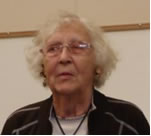
Eleanor Wyatt:
Every time you picked Sugarbabe up, she had something to give you. The ones that I purchased were the shovel and the hammer with the Batterson Barn. At the Lions dinner meetings she always had a gift to give for the drawing.
John and I got a saw blade one time. Then we got home and Sugarbabe called and she said, “I gave you the wrong saw blade – it was designated for somebody else.”
She was an absolutely fantastic person and loved life and was loved by everybody. My husband was the one who first suggested her as “Citizen of the Year”. What year was that? Probably about 1983….
Pat Clemens:
That might be an idea to have all the “Citizen of the Year” names too, and why. Are they all up at the fire barn?
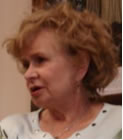
Susan Link:
I live in Fort Collins now and I was friends with the mayor in Windsor for a while, and Sue Reynolds and I took Sugarbabe down to the town hall in Windsor and let her sit up on the dais and the board of directors even gave her a gavel. She absolutely loved it. The mayor was trying to get her to say “Windsor” because she always said “Vinsor”. He’s say, “now, say where.” And she’d go “where.” And he’d say, “now say wolf.” And she would say “wolf.” And he said, “now say Windsor.” “Vinsor.” Then she would (say), “I knew I should have taken terapy.” But we loved her so much. She certainly made us laugh.
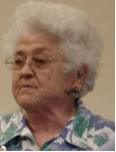
Audrey Robinson:
We’d be here all afternoon if I told all the stories with Sugerbabe. Sugarbabe and I go back, in fact I don’t think she was in the area ten minutes before I knew Billy and Sugarbabe. When I was working with Bonnie Drake making wreaths, this was our crew. We had Carol Arent, everybody knows her, and Marge Bickhous – does anyone remember her? (Affirmations of yeses from the audience.) Thelma Morrison, nope, don’t remember her. And of course Bonnie Drake – everybody remembers her, she made the wreaths. Ann Shank? Oh, I’m an old fossil up here…. And then Jerry Dalton – they used to own the Trading Post – does everyone remember that? That’s how far back Sugarbabe and I went. Actually there was about ten of us. Here is a picture of the whole gang and this is what Sugarbabe looked like back then. You’ve got to take a picture of this. This was our “family.” She would tell stories. And you really had to listen because she had such an accent. I got so that I was pretty good listening to her.
You didn’t do her a favor of any kind, but what you got something. I looked on the wall, and there were many. I’ve got two big pictures and I thought, there’s no way I’m going to pass those around. The picture I brought up to share … I had a severe illness and that was the gift she gave me. We lived just (near her) driveway, just south of where we live, we went down to the ranch where she was living. As I said, you couldn’t do Sugarbabe a favor but what you got ten things back. When I worked with her at Bonnie Drake’s every morning it was funny because she would tell us things that happened to her. Never sad stories, but it was always how she achieved this or how her family went through this. I couldn’t even begin to tell some of the stories that she told, but she’d always laugh about Billy. He was a character, as the family well knows. He was good to her, but he was a character. It was just a joy and a pleasure to have been touched by Sugarbabe in a very special way. I missed her terribly when she was gone; I really did. She and I had a really special relationship. This is a really joy to have been part of this and to laugh about some of the things she had told us.
Taking care of the kids, she would tell some about that. She was a soft-hearted lady. She was kind of a soft-hearted disciplinarian – am I right? I don’t know about the grandkids. But she was firm, but she wasn’t mean. Just working with her was a sign of that. When you’d work with her, she’d always excuse herself if she thought she bumped you, or something like that. Bonnie just dearly loved her. She was such a gifted lady in every sense of the word. Her pictures are an example. And that was all from scratch, am I right? She didn’t take any classes or anything like that; that was all a God-given gift. As far as when I worked with her, there were so many things – I just couldn’t begin to … because she never took advantage of something needing done. If it needed to be done, she did it. She didn’t have to be told to do it, she never argued about who had to do it. She’d work to help. She and I were always kind of guilty about that, if it needed to be done, we’d stay with Bonnie and help clean up, even as hard as we worked. I was a decorator and you could see her paintings … she was that way with everything she ever started, she was a great achiever. Am I right? Some of the things she told, and some of the stories about when she came over here … the kids could probably talk about that better than I can because I was so shocked at some of the things. I’m very innocent, very innocent, about some of the things that happened to those who came over here. I’m not sure how she and Billy met, I’ve forgotten the story. I think Billy was awful good to Sugarbabe, but he was a character. You had to know him to appreciate him. Very good to Sugarbabe – just a loving couple.
She was a war bride, that’s right, but Billy didn’t make an issue out of it, he made kind of a joke out of it, and I think Sugarbabe appreciated it because he carried and loved her. He kind of stole her, didn’t he – if I remember the story? Kind of picked her up and took off with her.
Jody Morrison:
The CD that I brought of her own history, you’ll have to listen to that. It tells her whole life from when she was in Austria.
Audrey Robinson:
I’m going to have to get one of those – it’s just been too long since I’ve heard the story to be accurate. As I had said it was a joy and a pleasure and a blessing to have been touched by her. I’ll never be the same person because of it. I made copies out of my album of these pictures, and you could put them in the book or do whatever you want to do with them. I just can’t say enough for her.
I used to admire what she could do, because I was a simple kid. I went out and got the greens to make the bouquets they made to put on the wreaths. Then I helped decorate the wreaths at Bonnie’s. (Sugarbabe) was one of the makers and decorators. There just wasn’t a whole lot she couldn’t do. If Bonnie needed something done, she always had Sugarbabe to help her afterwards. Words just can’t say what she was capable of.
A question from the audience:
A question…. Some of us are relatively new up here on the mountain. Some of us are old fossils and still new up here. We learned to love her because of her paintings. Certainly Sugarbabe was not her given name. How did Sugarbabe come about?
Jody Morrison:
I think it’s on the CD too. Her name was Herta Josephine Koch. My dad couldn’t pronounce it. He gave everybody nicknames. Our daughters – Gina was “red” and my other daughter was “slim.” I was Princess. My dad couldn’t pronounce Herta. I don’t know what show it was – “The Real McCoys?” A lady on that show was named Sugarbabe, and he called her Sugarbabe.
Audrey Robinson:
And he didn’t say it very nice sometimes. You had to know Billy to know what he said. They were a very unique couple and Red Feather was never the same after we lost them.
A question from the audience:
How long were they married?
Jody Morrison:
They were married in August of 1947 and dad passed away on October 18 of 1977, up here. She was alone for a long, long time.
Audrey Robinson:
I want to share something else about them. You know where they lived, on the ranch, the Hardin Ranch. The Mapellis, they insisted on Sugarbabe living until her end there after Billy died. We admired them and we told them, because that lady had a home until she was gone. Of course we all adopted her, doctored her, took care of her and made sure she was OK. We were within less than a half mile of her.
Jody Morrison:
And I loved that because any time mom was ill, I’d get a call from somebody up here letting me know.
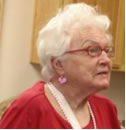
Nan Raybuck:
I have a story. I’m sorry I can’t come up there. I won a picture of hers of Batterson Barn and I thanked her of course. And she said, well since you thanked me, I’m going to give you something else. Up to the time you said you were going to have this meeting, I thought she had painted it – it was an enameled spoon. She had a big sense of humor and when Dorothy brought it up to me out of the basement, it didn’t say “Sugarbabe,” it said “Tracy.” And nobody knows who Tracy is.
Jody Morrison:
No, I don’t know….
Nan Raybuck:
This is painted exactly like she painted it. I always thought it was hers because she just handed it to me. Nobody – because I’ve asked everybody – knows. It was somebody who was her protégé, and I didn’t look at the name. I just assumed it had to be hers.
And it was the first time I ever thanked anyone for winning something.
But the spoon is going to be donated as a door prize at Mountain Gals because she did more door prizes than anybody ever did. If you know who Tracy is, let me know.
Audrey Robinson:
This is what she brought me (holding up a painting of Sugarbabe’s; see picture below) and this was the only one I could bring up that will swivel. I said, “what’s that for?” And she says, “well, because you’re you and you need it.” And I thought, well OK. And she put her card on the back of it. They just touched our heart in a big way.
Comment from the audience:
These pictures are to put in your book if you’d like them.
Pat Clemens:
I actually should have read this first. I know there are some people who never met her that are here, and this was in our newsletter. I just kind of assumed everybody had read it.
“’Sugarbabe’ was born Herta Josephine Koch on April 29, 1921 in Innsbruck, Austria. Sugarbabe met Billy Carnival during World War II when he was an Army medic stationed near Innsbruck. Billy named her Sugarbabe because he couldn’t pronounce her real name, Herta. She immigrated to the United States in 1947, coming through the Ellis Island Immigration Station. Billy and Sugarbabe were married August 1947 and lived in north Denver with Billy’s large Italian family. In 1953 they moved into their own home in Denver and had three children, Tex, Jody and Freddy. They lived there until Billy accepted a job in 1970 with Mapelli Brothers Meat Company as caretaker of a ranch in Red Feather Lakes. In 1971 they moved into the original Hardin cabin. It was a big adjustment from city life, but Sugarbabe soon learned to love the mountains and the people in Red Feather Lakes. She worked at Fox Acres for many years. Billy died in 1977 and Sugarbabe lived on her own in their little historic cabin where she became a self-taught painter. Never one to fret about “nothing to do,” Sugarbabe found a splintery piece of wood and using some charcoal from the fire discovered a liking for art. She never stopped drawing and trying out new mediums to express her talent. This early beginning blossomed into one of Red Feather’s most popular artists.”
Other stories: Jody, would you like to get up and say something?
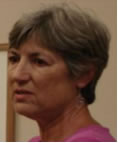
Jody Morrison:
Thank you everyone for coming. We really appreciate it. She was a wonderful mother and we miss her. I wanted to tell you that on the CD she talks about her life. One of the best things was that –who was it that mentioned this? – the “citizen of the year” meant everything to her. And she talks about that and how surprised she was that everybody had nominated her and how proud she was. Once she came to this country she was no longer a foreigner; she got her citizenship papers and she was a citizen of the United States. She was proud of it and she was a good citizen.
I have so many good memories of all the people up here. Our daughter used to come up. I worked summers. The girls would come up and spend the whole summer with my mom and dad up here. We were reminiscing on our way up here – we live in Denver – about how free it was. They’d go to the dump and get stuff; they’d climb the mountain with all the kids.
A comment from the audience:
I think one of my boys liked one of yours. He had good taste.
Jody Morrison:
I was going to tell you. Before dad and mom got the house and moved here permanently, they worked over for the Mapelli (Bros.) on the 4 Tree Ranch. That was over in the Poudre Canyon. She would come up summers with my brother Fred Carnival and he lived up there with them until he married and then he moved down to town.
She started painting over there actually. This is on the CD too. This is one of her earliest paintings. (See photo below.) It’s from a board from the house over there. I just love that one, I think that’s really pretty. She would use whatever she had. She’d find house paint, or whatever. Just to keep busy over there – she liked to keep busy. And this one, on the back – this was one of the first ones she painted too – was India and she repurposed it, and this was in her little cabin, and I think it’s one of the nicest ones.
And this is just a little outhouse. She liked to paint outhouses and this little board has a hole in it already. This is `78, so that’s really early. And this one – Gina had this one, Gina has several of her things too, and this is when she started painting on a saw blade. Whatever she could find she would paint on.
Audrey Robinson:
Richard even gave her some blades that were rusty….
Jody Morrison:
She was all around to everyone up here and down to the saw mill and she would ask for them to save them, and they would. Then she’d polish them. She was always using electrical tools, sanders and saws and stuff that we didn’t want her to use because she was kind of clumsy.
Everybody was so kind to her and she loved it up here. It was very much like her country in Austria. But she was alone for quite a few years. We’d come up on the weekends.
The other thing is, you all knew that she always gave everything away. She never kept anything. She was hard to buy for, for birthdays and Christmas and stuff, and so we would give her a camera, and the next time we’d come up we’d see somebody and they’d say, “oh yeah, your mother …” A $200 camera. “Your mother gave me this!” Then we started giving her money and then she’d send the money to the grandkids or buy something for the grandkids. So we decided … she loved to travel and she wasn’t able to travel by herself, so we started taking her places. Larry and I used to work for the National Park Service and we would take her to the National Parks. She loved that. And she would hike – she was 83 and at Zion there’s this “three sisters trail.” Eighty-three years old and she hiked up. She let everybody on the trail know she was 83 and they could do it, no sitting down.
She had a big influence on our children, on our daughters and on the grandkids too. They loved coming up on the weekends. Gina still feels like she is kind of a country girl because of all the time she spent up here.
Then later, we started taking her – she missed her home in Austria so Larry and I would take her to Austria every year in the fall. We would live in the home she grew up in. Her brothers were from that area. They would take us all over and it was a beautiful, beautiful place.
The other thing that happened about the wreaths … that was hard, hard work for you guys and not only did you make them but you collected all the stuff. We were always petrified about her. She’d go out by herself and collect that stuff, everywhere, up Deadman. Her car would get stuck, but she was never afraid to do anything. That was before cell phones. She’d just be out there. She would make hundreds and hundreds of wreaths and then we would come up in Larry’s truck and I would sell them at the park service. Everybody looked forward to this for years and years. She’d sell them for $10. And she gave a lot away. So the truck would be piled high with these. At lunchtime my girlfriend and I … anybody who had bought and paid for them they’d come out at lunch, and it was freezing sometimes, and we’d dole out the wreaths. That’s one of my favorite memories.
She was a very creative cook. I don’t think she ever used a cookbook, but she was a good cook. She had this pressure cooker and she was always cooking stuff in there. The pressure cooker was old and didn’t work very well, and sometimes it would blow up and there’d be stuff all over the table. She made these beautiful … she called them German pancakes but they were like a crepe. We’d go up on the weekends and before any of us were up, the kids and the grandkids, she’d be out there making stacks of these. Sometimes she’d have too much oil in the pan and the pan would catch on fire. She was always doing things like that.
One time we were getting ready to go to Austria and she was cleaning up her kitchen and stuff. For some reason there was a gas…. The stove was here and she was cleaning under the sink and there was a gas leak. She was using spray paint or something to paint, and it blew up and singed off her eyebrows. She was always doing crazy stuff.
One time – they had a basset hound, a dog, and he got sick so they got pills for the dog. Then my mom got terribly sick and she thought, well, if the pills are good for the dog, they were good enough for her. She got so sick, they didn’t know what was going on.
It was always an adventure with my mom. She was always very thrifty. In Denver we’d go to the thrift shops. She sewed all our clothes. I don’t think I had a dress from the store until I was like in the seventh grade. She made everything and repurposed everything. She was such a good lady and we loved her.
It was such a relief for her to be up here. Even after my dad passed away because I knew she had a good life and everybody looked after her and she was well taken care of.
Some of the calls I didn’t care for too much because she got a little crazy. She liked men, she liked her men, and she had a boyfriend. That became a bit of a problem sometimes. But it was always fun. She lived life every day. Thank you so much.
A question from the audience:
Did you grow up here at all?
Jody Morrison:
No, I didn’t. I was actually married by the time they moved up here. I was married in the `70s and I had a kid. But we did come up every weekend. Larry and I worked at the Denver Service Center and it’s still there. It’s a design center for all the national parks. My husband was in charge of the graphics division. They did the planning documents, like the development-concept plans, and the general management plans and all that stuff. And I worked in the library. I’d get calls from all over the United States and everywhere for like drawings of Yellowstone National Park and documents about the parks. I’d send them out to the people. We had the brochures, the park brochures. It was a great job.
A comment from the audience:
She taught me to play “31”.
Jody Morrison:
Oh, she loved cards! She taught her to play “31.” She’d lend you a quarter? That was another nice thing about this community, they would get together and play cards and they’d have lunch.
Audrey Robinson:
I remember she came to Mountain Gals one time and she won at Bingo or something and she thought that was the greatest thing. “I won,” she said, and she just got so excited.
Jody Morrison:
She was lucky at everything, wasn’t she Sue? Oh yeah, she won all the games. I don’t know how she did it.
A comment from the audience:
She’d always take a quarter and she’d hold it until it was her turn, and you knew she was going to “knock.” So everyone found out when she was going to win.
Jody Morrison:
She was a very smart person, but you’d never know that. She was pretty sharp. Lucky I had ….
Audrey Robinson:
When I think of her, she was not a user. She didn’t abuse your friendship. We have some, that no matter how much you do, you can’t do enough. But not her. She’d always want to pay you back. And she wouldn’t let you do things for her.
Jody Morrison:
She was stubborn; we’re all stubborn.
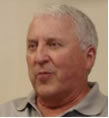
Larry Morrison:
Well, I’ll say a few words; I’ll make it quick. I’m Larry Morrison, Jody’s husband and Sugarbabe’s son-in-law. I kind of perceive myself as being the long-suffering son-in-law. Everybody talking about the saw blades and that, she had been working with saw blades before Jody and I got married in `78. She would try to clean these rusty saw blades with power tools. That’s kind of what led to my involvement with her. She was not qualified to use power tools, probably anything electrical, a saw, or anything power. So she found out I was restoring a car at the time and she found out I had a sand-blaster. All of a sudden, every time we came up to see her, the back of my truck had new (old) saw blades in the back of it. Bucksaws, and long – she had some of these saw blades that were literally three or four feet across. It took me hours to clean these things, even with the sander. And I would just get the batch done and be real happy and bring them back and she’d say, “I have some more.” That’s my involvement with that part of it.
And the other part is just the incredible community that you all provide up here for each other. It was something that absolutely amazed me, how intertwined you all were and how you took care of each other and supported each other, interacted with each other. It was just … especially as communities now are so transit and your neighbor comes and two years later they’re gone. But she had friends that we heard about for years and years and we met when we came up here and got involved with her activities. It was all of you that made her life as full as it was. Great people! It touched me to see what others can do for people. You get so separated from it in your regular everyday life and then come up and see what a real community is. You all should be proud of yourselves for taking care of each other. That’s it….
Jody Morrison:
Talk about the saw blades. She’d get all kinds of junk from the auction and (Larry) would sandblast what these people gave.
Larry Morrison:
… she’d say, well, I got these from somebody else.
Jody Morrison:
(My father) said, “so what’s she going to do with these?” I said, “Dad, she paints on them. You’ve seen them all over sanded down.”
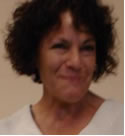
Jo Johnson:
I’m Jo Johnson and my husband Lyn and I were caretakers on the ranch with her; for 13 years we were there. We just have such wonderful memories and my kids were lucky enough to be babysat by her when they were growing up. She’d watch them for an hour or two. They just loved being in her home and she treated them just like her own children.
Probably two really good memories I have were every holiday she would make her little cookies (murmurs of agreement, recognition from the audience). And you wouldn’t just get a few of them! We’d get a huge box of them. And those were wonderful. Now you see them in the stores and I just always think of her when I see them.
And the second thing is, she was a hiker. She loved to walk the property and I remember just taking my girls, not very far because they were still little, up on the hill and we could hear her yodeling. It was the most wonderful sound and the most wonderful memories that I have about her.
She is, was, a special, special lady and she’ll remain in our hearts. And we have one of her art pieces on a saw blade. So every time I’m in my kitchen, I think of her every day (when) I look at it. Great time, great memories on Phantom Lake Ranch with her.
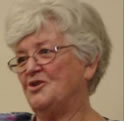
Sue Reynolds:
My name is Sue Reynolds and I first met Sugarbabe in 2000 when I moved up here. I’m a nurse, a retired nurse, and when I moved up here I didn’t know anybody. So one morning I decided I’d go over to the Pot Belly and have breakfast. That’s where I met Sugarbabe. She was in there with several saw blades, some of the long ones, you know, like this, and the big ones. Fred Reichert was in there and she was selling some to Fred. Later Fred became (involved) in a contest with Sue Link and I. We all got to know Sugarbabe really well, we went to town with her. She used to say, “oh, let’s go up and go down the Laramie River.” We were traveling all the time, doing something. Sue and I got to know her really well. We couldn’t take her to town without getting a saw blade or some kind of painting object. We got to know her really well. She was really special to me. I could tell you stories … I could set here for two or three hours and tell you stories about Sugarbabe.
Some of the ones you’ve already told and I’ll just say a little more about. She was a hiker. And I like to get out and hike. I don’t think there is anywhere on that ranch where she lived that we didn’t touch. One day she said, “Sue, bring your dog over here.” Well I don’t know about that… “Yeah,” she said, “bring your dog.” I said, “you’ve got a lot of horses out here.” “Well, they won’t hurt her.”
I had a golden retriever, Sarah was her name, and after that, Sarah always wanted to go hiking with Sugarbabe and I. But that day the horses surrounded her and they were just getting closer and closer. And poor little Sarah didn’t know what to do about all these horses. And I said, “they’re all going to hurt her.” And Sugarbabe said, “no, I’ll take care of those horses. I bottle fed every one of them.” She went over and just shooed them out and took a hold of Sarah and walked out with her. Before we finished that hiking trip, Sarah had hit every mud hole, every horse dropping, every cow dropping, and I’m not kidding you, she was a mess. I thought, oh, I hate to put her back in my car. I said, “Sugarbabe, do you have a hose?” “No, I don’t have a hose.” Then she said, “You’re not bringing her in this house!” So we used to have a lot of fun hiking.
Sue and I got the idea one day that we were going to help Sugarbabe with her paintings. We loved them. But we’d never done much painting and – Sue Link I’m talking about here – she won the award for painting one year … (in a) Bob Ross (program). We thought Sugarbabe would like to go with us and learn to paint (using the Ross method). Well, she went with us all right, but she set there and she said, “Don’t like them, don’t like them.” And she would not paint. Later Sue and I said why did we ever think we could have somebody teach Sugarbabe how to paint?
But it was fun. We had a lot of trips, we played a lot of cards. They used to have Karaoke each Saturday night at the Pot Belly. Sugarbabe loved to go, but she said, “Sue, I don’t want to go where there’s all those people. I don’t know a lot of those people.” Well one night she really had a couple of beers and was feeling pretty good. I said, “Sugarbabe, can’t you sing – can’t you get up there and sing?” “I can’t sing,” she said. Donna, the host of the Karaoke would say, “Come on, Sugarbabe, I’ll sing with you.” She got up and did a yodel, the whole song. Everybody could not believe it. It was beautiful. She was very good at it, but to get her to do that was a real trick.
Jody Morrison:
She had a beautiful voice, and my dad played the guitar. To this day, when I hear You are my Sunshine…. They sang together a lot.
Sue Reynolds:
I don’t know how many stories to go with this, like I said, I could go on forever telling stories about Sugarbabe.
The other thing, Sue and I decided to see who had the most paintings of Sugarbabe’s. And she said, “you count yours and I’ll count mine.” Fred said, “well, you’re not going to count them without me being involved in that,” so the three of us counted them and I beat Fred by one. I had 55, he had 54 and Sue had 52. That’s how many paintings we had. Every time we went anywhere or did anything, you got a painting. I’ve given a lot to friends, and I’ve still got a lot and I treasure every one of them. My favorite one’s hanging up out in the (Library) Gallery, of the sled, and no Jere (Walack), we’re not going to auction it off.
Jere Wallack:
I know where you live….
A comment from the audience:
Some of those blades were so mammoth, she couldn’t even move them!
Sue Reynolds:
One day she said to me, she said, “I have a saw blade, Sue, out at the back of the cabin.” She said, “my husband never really liked that one.” But she said, “it’s been out there and it’s the very first one I ever painted on.” I have it over my hot tub now and I treasure it. But it took two guys, including Jere, to take it down off the barn and put it over the hot tub. It’s a beautiful one, it really is.
There’s no end to how many ….
A comment from the audience:
And she painted in her bathroom.
Sue Reynolds:
She had her easel on top of the dryer.
One time I took her to Laramie `cause she’d run out of saw blades. She said “Sue, I’ve got to have something to paint on; would you take me to Laramie?” I said, “do you know where to go once we get up there?” “Yeah,” she said, “I know where to go.” “OK, sure, I’ll take you up there.” Well we get up there and she has no idea where to go…. We went to where she felt the saw mill was, but it had since closed. We spent all day driving, trying to find a saw mill. We finally found one and these guys were so happy. Some of them knew her. (One) said, “come with me, I’ll give you as many as you want.” We went out … and I think we carried home 62 saw blades that day. What would happen, they would sharpen them and then there’s nothing left to sharpen. Then they just threw them in the barn back there. We carried all those home, and of course, I guess Larry helped her get them smooth. Two of the guys in there knew her, and she said, “don’t worry, I’ll give you one back, and I’ll give you one back; what would you like on them?” One was a little Mexican guy and he told her what he wanted, the flag of Mexico and all this, and she said, “I’ll paint it on there for `ya.” And the other guy had horses, and she painted horses on that one. She called me in a couple of days and she said, “we got to go back.” And I said, “already?” She said, “I’ve got them both ready and I’ve got to get them back to those guys.” We went back the next day and she took two saw blades. About a week later there was guys from that mill coming down to her cabin bringing her saw blades! And she painted every one of them. We had a good time. She will always be right here.
Libby Jefferson:
I forgot. One time when she was short of saw blades my husband made these little wooden blades and there’s one in there in the display, and it has a magnet on it for the refrigerator. So he made her a batch of them thinking she’d paint them and sell them. She promptly brought them all back to us painted. We were going to New Zealand and Australia so we took them and left them at every place we where we stayed at the bed and breakfasts. I don’t think they know what they’ve got.
Emma Grauberger also attended the event and has shared her memories of Sugarbabe within the Emma Grauberger Interview (July 19, 2011).
Pat Clemens
Any more stories? Did everybody sign the sign-in sheet as it came around? We also have cookies and you can talk to the family, talk to each other, if you get over to the display in the gallery, look at it. We thank you for coming.
Transcription by Linda Bell
*****
Photo Gallery from the presentation, “Sugarbabe Day”
